|
Crayfish, Crawdads, Yabbies, Ditch
Bugs
Parasitic Disease
FAQs on Crayfish Disease:
Crayfish
Disease 1,
Crayfish Health 2,
Crayfish Health 3,
Crayfish Health 4,
Crayfish Health 5, Crayfish Health ,
FAQs on Crayfish Disease by Category:
Diagnosis,
Environmental, Nutritional,
Trauma,
Infectious, Social,
Treatments
Related
Articles:
Forget
Crawfish Pie, Let's Make a Crawfish Tank! By Gage
Harford, Invertebrates for Freshwater
Aquariums by Neale Monks,
Freshwater Shrimp, Crayfish,
"Lobsters", Prawns
Freshwater to Brackish
Crabs
Related FAQs:
Crayfish
1,
Crayfish 2,
Crayfish ID,
Crayfish Behavior,
Crayfish Compatibility,
Crayfish Selection,
Crayfish Systems,
Crayfish Feeding,
Crayfish Reproduction,
Freshwater Invertebrates/Use in
Aquariums, Freshwater Crustaceans for the Aquarium,
FW Crustaceans
2,
Fresh to Brackish
Water Crabs,
Hermit
Crabs,
|
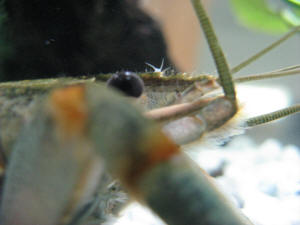
|
|
Epistylis on crawfish 9/14/18
Hi, my name is Susan, i have 6 Louisiana swamp crawfish that i rescued from one
of our crawfish boils. In the last month they have developed a white fuzz all
over them. the best i can tell from all the internet searching is that it is
Epistylis. But i cant find anything on treating it. 3 of the crawfish are
berried and some of the eggs on 1 also has the fuzz. Please advise on how to get
rid of it. My perimeters are all good, and i do monthly water changes.
<Epistylis spp. are commensals, not parasites, so while they might be
unattractive to look at, they don't do any actual harm. However, because they
grow in water with plenty of planktonic algae and bacteria that they can feed
on, they're seen as indicators of poor environmental conditions.
More specifically, high levels of organic material and mineral nutrients in the
water. So your best approach to tackling them is two-fold. First, find out how
to improve ambient conditions. More water changes/removal of uneaten food, more
filtration, and less (wasted) food would all be part of this. Secondly,
understand that since these ciliate Protozoans are attached to the exoskeleton
of the crayfish, they will be "shed" during successful molting, in which case
quick disposal of the old exoskeleton would be helpful. I would remind you of
the need for iodine in the diet to ensure successful molting (for some reason
moults frequently fail under aquarium conditions otherwise) and also for a
source of calcium, such as unshelled shrimp, if you're going to remove the old
moult (crayfish normally consume the moult, in part, to recycle the minerals).
You could also try medications used against other ciliates (such as Velvet and
Whitespot) but they are likely to be toxic to crayfish unless clearly stated as
"safe for
invertebrates" on the packaging. Cheers, Neale.>
|
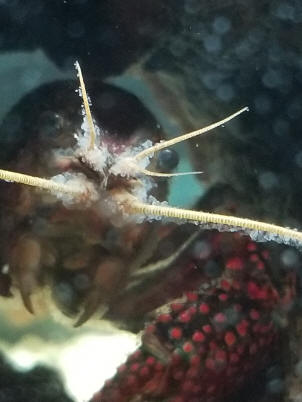 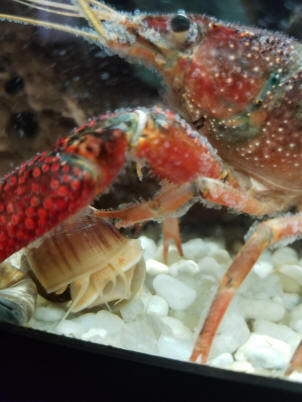 |
|
Crayfish translucent growths
10/7/17
Good day!
<Bonjour!>
I impulse bought a 3" Tangerine crayfish and now I'm scrambling to buy the
materials to cycle a 10g long tank but for now I'm keeping her in a small 2.5
gallon tub with a sponge filter until then. She recently molted (But lost some
limbs because she had horrible shell rot from the shop) and now its been 13 days
i have noticed growths from the stumps of her lost appendages!
<Indeed. These are likely 'benign' Protozoans, bacteria or fungi that grow
wherever there's plenty of dead organic material. They're benign in the sense
that they're not aggressive pathogens that will make your crayfish sick, but
they're still undesirable. An antibacterial and antifungal medication known to
be shrimp-safe (such as eSHa 2000) could be used here, alongside optimising
environmental conditions. To a great degree this sort of 'fluff' grows on
crayfish in tanks that have less than perfect cleanliness. The more gunk for
them to feed on, the more the Protozoans and fungus will spread onto your
crayfish.>
i don't have a test kit yet so i cant tell the parameters but i do a lot of
partial water changes every other day and feed her veggies and sinking pellets.
<Good.>
She's acting so differently now and she's just scared of everything unlike
before (maybe its because she also lost her claws).. but i digress, the growths
look feathery and have spots in them, attached here is a photo i took of her in
an ice cream container while i was cleaning the sand in her tub (there was
rotting broccoli pieces hidden so it was stinking to high heaven)
<The photo isn't sharp enough to see exactly what the problem here, but for now,
I'd assume the benign fluff described above rather than an aggressive crayfish
parasite. Still, if you can get tack-sharp photos, sites like
PetShrimp.com have active forums with numerous experienced crustacean-keepers.>
Thank you for helping, I've added some antifungal meds (no copper) but i just
want to help her get better soon.
<Understood. Good luck, Neale.>
|

|
Re: Crayfish translucent growths
10/8/2017
Thank you for the reply!!
<Welcome.>
Just adding again but here's another pic of Megatron i took the same day, is
this photo better?
<Not really. It's not so much the size of the photo as the fact the bit of
interest, the fluff around the legs, is basically a blurry mess with black
speckles.>
its got dark spots and it worries me to no end.
<They look like baby crayfish, what with the black spots and all! Cheers,
Neale.>
|
 |
|
Cray fish worms, just using/reading WWM 5/12/09
I have had many crayfish over the years. Gimpyshrimp<his name was
missing 3 legs and a pincher>
<Mmm... Crays should regenerate these in subsequent molts... see WWM
re their health>
has the worms/parasites that come out by his eves, top of
head, thorax, and every overlay of his shell.
<This is also covered>
This is the only crayfish that I have noticed them. I got 2 really good
pictures of the worms on him. They need to be magnified 4x on my 4 meg
camera. If you would like to see them write me back at XXXX my
girlfriend will have to show me how. I am not good on the comp., just
learning. I never saw one molt until I watched it on your site thanks
very much
<Please read here:
http://wetwebmedia.com/FWSubWebIndex/crayfishdisfaq.htm
and the linked files above. Bob Fenner>
| Crayfish
parasites? Hello Crew, I have had my first crayfish,
Claudine (Claude till I realized 'he' was a 'she'!)
for four weeks now. She's a Cherax quadricarinatus. She shed
her skin five days ago, and since then I have noticed some sort of
parasite on her. I have scoured your website, but not found
anything quite the same in the links. They are opaque to white in
colour (and seem to get whiter as they get bigger) and look like
tiny slugs. I don't think they move that much, but certainly
stretch out. They have little antennae of some sort, which wave in
the water. I have spotted about five of them. The most obvious sits
on her head (as in the first photo), she has another couple at
least in the 'cavity' around the eye area, one nearer to
her 'mouth' (second photo, you can see its head near the
dark patch in the middle of the picture) which is very active when
she feeds, and one in the joint of one arm. I don't think they
bother her, apart from the fact that she seems to 'blink'
(flicks her eyes inwards!) quite a bit more than she used to. They
really bother me though! I don't know whether this is normal
for crustaceans as I have never kept anything like this before. The
measurements for nitrites, nitrites etc. are all normal, and
following the advice on your website, I have added a drop of
iodide. Do you know what they are, and whether I should/can get rid
of them? Are they harmful? I haven't attempted picking her up
before as she's quite new and I don't want to frighten her.
I think the only one I may be able to remove is the one on her
head, but would need any advice on how to pick her up! Many thanks
indeed for your help, Kathryn <Kathryn, it's difficult to
say precisely what these little animals might be. They could be
parasitic, but it's more likely they are merely commensal, that
is, they live on the crayfish but don't cause any direct harm.
There are a few similar reports on the Crayfish FAQ page, here:
http://www.wetwebmedia.com/FWSubWebindex/crayfishfaqs.htm In any
case, treatment is likely impossible. Anything toxic to the
"worms" would be poisonous to the crayfish. You could of
course pull them off with tweezers or forceps, but at a risk of
harming the crayfish. You could remove the next molt as soon as you
see it, on the theory that might lessen the chances of re-infection
(though crayfish do best when allowed to eat their molts and
recycle the minerals therein). Bottom line, best left alone.
Cheers, Neale.> |

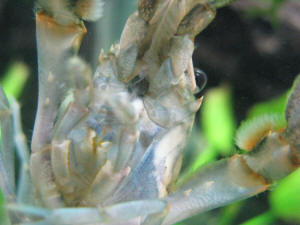 |
Freshwater Crayfish Infested with White worms.
(Branchiobdellida?) - 0713/2006 Hi to whomever reads my email.
<Sabrina with you, today.> My little Procambarus clarkii (Leonid)
has been living by himself for a while and has been doing ok, we bought
a better sponge filter for him, and took him out to examine him as a
checkup. We noticed the parasites <Your guess that these are
Branchiobdellida is probably spot-on. Typically, these are harmless,
but there may be some species that can damage the animal somewhat.>
and have a Malachite green and Chitosan formula (Mardel Maracide) which
we tried using on a fish (Betta). We counted at least 10 of them that
were visible. Is this Maracide safe to use on a crayfish? <No. This
is toxic (at best) to the Cray, and may even kill it. In general, it is
best to just never use medications with invertebrates present. Most
anything designed to kill parasites will harm pet invertebrates. If you
feel you must remove these worms, do so manually by gently (gently!)
scraping them off with a fingernail, cloth, or brush with the Cray
submerged in a bowl of tank water.> Also, is there any possible way
to prevent this from recurring? <Not effectively. Just remove as you
see necessary.> One other question not related to the Worms, my
other 2 crayfish are robustus, <Neat!> and one is female, the
other male. If I choose to breed them, how much of a size difference
between them can there be? <Preferably not significant, or the
larger animal may damage the smaller one.> The male (Vladimir) is
about an inch longer than the female (Mavra). <Mm, not quite
descriptive enough.... I mean, if the male is 2" and the female is
1", this is a significant difference.... though, at that size,
they're not going to breed :grin: If, on the other hand, the
male's 7" and the female's 6", this is a fine size,
and no worries.> All help appreciated, Colin. <All the best to
you and your crayfish! -Sabrina>
Freshwater Crayfish
Infested with White worms. (Branchiobdellida?) - II - 071*/2006 A
more descriptive way to explain would be that measuring from tip of the
head to tail, Vladimir is about 4 1/2 inches and Mavra is about 3
inches. I am thinking of waiting a while for Mavra to molt and I think
this will allow her to get within a 3/4 of an inch of Vladimir, hoping
she could possibly become 3 1/2 to 4 inches. <Sounds good. I might
give it a little longer. Definitely wait until her shell's hardened
completely - a few to several days after moulting, if possible.>
They share a tank with a divider in the middle, and I see them looking
at each other. Do you think this could be considered flirting?
<Either it's crayfish love, or they're looking at each other
as a potential dinner. I'd bet they're starting to feel
amorous.> Also with the Cray and the meds, we had tried the meds
before I received your most informative response, <Yikes!> he sat
in the formula for a couple of hours and when I saw the email I quickly
picked him out and changed the water. <Ahh, whew! I'm VERY glad
to hear/read this. Thank you for acting quickly. All the best to you,
-Sabrina>
Re: Freshwater Crayfish Infested with White worms.
(Branchiobdellida?) Crayfish Continued - 07/27/2006 Dear Sabrina,
<Hi, Colin!> I am very happy that I can email you using my
Gmail's reply, you are the most valuable source of information
about my freshwater crayfish. <Glad to be of service.> My dwarf
frogs have died off, <.... why?> but left a nice open area for
someone to live, I am considering getting a new 10 gal tank and giving
it to Mavra, then Vladimir, being the bigger Cray, shall get the whole
15 gallons to himself. Would it be a good idea to introduce Vladimir to
Mavra when we decide to, inside of the 10 gal, then allow Mavra to go
through her short period of motherhood before moving her to somewhere
else? <Possibly. Just be sure that there are LOTS of good nooks and
crannies for her to hide in. A pile of PVC joints and elbows or
clusters of rocks/caves would be good.> My father thinks some kind
of Cleaner shrimp would help the tanks, but I am afraid the crayfish
would just eat them, <Likely - but possibly they'd be ignored.
I'd make an attempt with very inexpensive shrimp (like ghost/grass
shrimp) if you try this.> if shrimp would not work, what else would
be safe from the power of the Cray? <Maaaaaaybe snails.... Perhaps
Septaria sp. snails would work best....> Big news with Mavra, her
rear left leg is growing back. <Excellent!!> We noticed a small
white pinkie growing out of her leg, and now it is growing larger.
<This is a very clear sign of good health.> I appreciate all of
your help and wisdom, Colin <As always, I'm glad to help out.
Wishing you well, -Sabrina>
- Crayfish Parasites - I have two freshwater crayfish (they
are probably Florida Crayfish and they are approximately 3" long)
in an Eclipse Six Tank. We have had them a few months. I just noticed
many parasites on them. They look like small white worms approximately
1/16 - 1/8" long. <Quite likely one or more varieties of Branchiobdella which is an obligate crayfish parasite.> I also see
white specs all over the glass. How do I kill these parasites without
killing the crayfish? <Hmm... well, I had to look this up on the
Internet and actually used Google and put in the subject of your email,
"Crayfish Parasite" - if this is indeed Branchiobdella then
there is no known treatment. Do not introduce these crayfish into the
wild or to other captive crayfish as the parasite will spread.>
Please advise A.S.A.P. Thank you. <Cheers, J -- >
Crayfish parasites I have an electric blue crayfish which I
purchased a couple of weeks ago at our local pet store. Over the past
couple of days I have noticed some (5) small white creatures
(approximately 1/8th inch) that are inhabiting around the nose and the
base of the feelers. They look like a tube with 2 tiny arms at the top
(one on each side) and as I was watching them one of them kind of
flipped end over end to move up the crayfish's head. Also when I
was feeding my other fish in the tank (33 Gal) and the flake food moved
past one of these so called parasites it looked like it tried to grab
it. Any ideas as to what these are or do you require further
information. <I'm sorry I really am uneducated in crayfish other
than catching them in the local creeks here, so I had to look up and
see what I could find. You might look at this site which seems to
really have a handle on crayfish http://us.geocities.com/crayfishdisease/pages/intro.html.
Good luck, MacL> Thanks, James
Crayfish With Ich? - 12/13/2004 Hi, I was wondering if
crayfish can get ich. <No. Ich (Ichthyophthirius multifilius) is an
obligate fish parasite - the Cray cannot be affected by ich. A Cray
can, however, have ich cysts stuck to it, while the cysts are
reproducing and before they become free-swimming in search of fish.
These would be totally invisible to the naked eye, and can be stuck to
anything from an infected tank - gravel, plant, and crayfish alike.>
I have one that I saved from the feeder goldfish tank at my work. Once
I got it home I realized it has what looks like ich on it. <It's
more likely either his coloring or bits of detritus stuck to him. I
wouldn't be terribly worried.> I can't seem to find any info
on treating crayfish with ich though, which made me wonder if it is ich
at all. <Very, very highly unlikely.> I do not want to introduce
him to my tank if he could make all my fish sick. <As above, he can
have (invisible) cysts stuck to him - I wouldn't be too worried,
but it would be best to quarantine him anyway, as it is best to do
before introducing any animal to your established tank.> I have a 20
gallon heavily planted (swords, and frills) tank with one Creamsicle
and one silver Lyre-tail (sp?) molly, their new fry, a dragon fish,
<This common name is applied to a few different critters.... but any
one of them (Polypterus sp., Erpetoichthys sp., Gobioides sp.) will all
outgrow a 20g tank in short order - and the last, Gobioides, is a
brackish animal. Please research this fellah a bit, find out what you
have, and what your options for it might be.> a rummy nose tetra,
and a gold mystery snail. I really don't want to get ich and have
to uproot my whole tank. <Agreed. Ich sucks.> Any info would be
great. <As above, your absolute safest bet is to quarantine *any*
new livestock before adding to your tank. BUT - this is pretty
important - a crayfish really isn't a good tankmate for any of the
fish that you've mentioned; any/all of them are more than likely to
end up as crayfish food eventually. I urge you to set up a new tank for
the Cray (even just a very, very simple 10-gallon setup would suffice).
One cool bonus is that this is more than likely Procambarus clarkii,
and you would not at all need a heater for his tank. Crayfish are
unbelievably interesting animals to watch and care for, I think you
would really appreciate him if you can give him a place to call home. I
also urge you to read crewmember Gage Hartford's excellent and fun
article in our online Conscientious Aquarist e-zine, on care and
breeding of crayfish: http://www.wetwebmedia.com/ca/cav1i4/crayfish/crayfish.htm
> Thanks, Candice <Wishing you and your crayfish well,
-Sabrina>
| Electric blue crayfish worms??? I have trying the
product Maracide now for the past seven days and the worms are
still on my electric blue lobster (crayfish). <Yes... this
product is for infectious disease agents...> I have tried to
take some pictures to show you <Very nice> but as I said
before the worms are so small you can't really see them. He has
a small white marking on the top of his head and near the bottom of
his tail were the worms stick out of. He also has about a hundred
or so on the bottom of his belly. The worms are not on anything
else in the tank. I also have a blue crayfish in with him and about
25 or so guppies. None of which are infected. I am sending a few
pictures and hopefully you will be able to see what I'm talking
about. The worms in the picture are located in the middle of his
eyes. Hoping to hear from you soon Thanks <Mmm, you can/could
try actual Anthelminthics, compounds that are toxic to worms, but
not (much) to other invertebrates. Please see here:
http://www.wetwebmedia.com/fshwrmdisfaqs.htm and the next
Related FAQ file, and the links where they lead you. Bob
Fenner> |
|
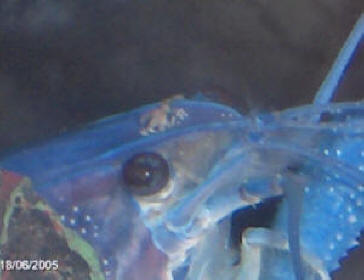
|
|
|

